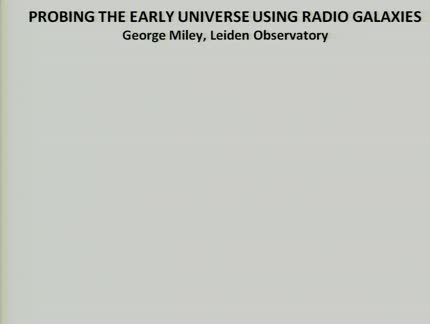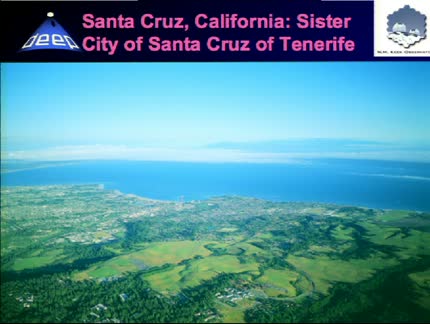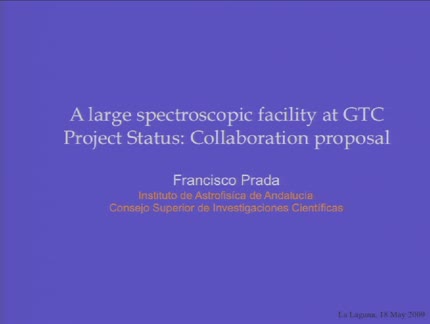Found 89 talks width keyword galaxy evolution

Abstract
Despite speculation that both starburst and nuclear activity in galaxies may be intimately linked via the common triggering mechanism of mergers and interactions, very little is known about the true nature of the link. Thus, the role of AGN in the formation and evolution of galaxies is still not well established. I will present deep Gemini/GMOS imaging observations which are used to investigate the triggering mechanism(s) in a complete sample of radio-loud AGN for which, uniquely, we have quantified the level of both the AGN and star formation activity. I will show results on the proportion of powerful radio galaxies triggered in galaxy mergers and also on the link between the degree of star formation/AGN activity and the interaction status of the host galaxies.
Abstract
Luminous high-redshift radio galaxies (HzRGs) are associated with the most massive known galaxies in the early Universe. These galaxies have the properties expected of the progenitors of dominant galaxies in rich clusters.
I shall describe the properties of HzRGs and demonstrate how they can be used to study the formation and evolution of galaxies and clusters. I shall also show how LOFAR, the new European radio telescope, can be used to extend these probes into the epoch of reionisation.

Abstract
Galaxies are the basic building blocks of the Universe, and understanding their formation and evolution is crucial to many areas of current astrophysical research. Nearby galaxies, being the 'fossil record' of the evolution of galaxies, provide a wealth of detail to test extensively the current models of galaxy formation and evolution. A galaxy's structure is linked to both its mass and evolutionary history. Probing galactic structure requires understanding the distribution of stars among galaxies of all types and luminosities across the full range of environments. We are performing a complete volume-limited (d < 40 Mpc) survey of over 2200 nearby spiral, elliptical and dwarf galaxies at 3.6 and 4.5 μ in the Spitzer Warm Mission to address fundamental questions of galactic structure that are united by the common need for deep, uniform, unbiased maps of the stellar mass in galaxies. I will introduce the survey, give examples of images and of the science that can be done, and explain how other researchers at the IAC can become involved in analysing these exciting data.
Abstract
AEGIS (All-wavelength Extended Groth strip International Survey: aegis.ucolick.org) is on-going survey that opens up new views of the development of galaxies and AGN's at redshifts z about 1. AEGIS is panchromatic like GOODS, with coverage ranging from X-ray to radio, and nearly as deep but more panoramic by covering a 4x larger region. Its backbone is the most Northern (accessible to the GTC) of the four fields of the DEEP2 Keck spectroscopic survey, which provides not only precision redshifts that yield reliable pairs, groups, and environments, but also internal kinematics and chemical abundances. After an overview of the DEEP and AEGIS surveys, I will share some recent highlights, including using a new kinematic measure for distant galaxies to track Tully-Fisher-like evolution; discovering metal poor, massive, luminous galaxies; finding ubiquitous galactic gas outflows among distant star forming galaxies; and exploring the nature of distant x-ray AGNs.
Abstract
The coalescence of a massive black hole (MBH) binary leads to the gravitational-wave recoil of the system and its ejection from the galaxy core. We have carried out N-body simulations of the motion of a M=3.7 M⊙ MBH remnant in the “Via Lactea I” Milky Way-sized halo. The hole receives a kick velocity of Vkick = 80, 120, 200, 300, and 400 km/s at redshift 1.5, and its orbit is followed for over 1 Gyr within a “live” host halo, subject only to gravity and dynamical friction against the dark matter background. We show that, owing to asphericities in the dark matter potential, the orbit of the MBH is highly non-radial, resulting in a significantly increased decay timescale compared to a spherical halo. The simulations are used to construct a semi-analytic model of the motion of the MBH in a time-varying triaxial Navarro-Frenk-White dark matter halo plus a spherical stellar bulge, where the dynamical friction force is calculated directly from the velocity dispersion tensor. Such a model should offer a realistic picture of the dynamics of kicked MBHs in situations where gas drag, friction by disk stars, and the flattening of the central cusp by the returning hole are all negligible effects. We find that, in a Milky Way-sized galaxy, a recoiling hole carrying a gaseous disk of initial mass ~2 MBH may shine as a quasar for a substantial fraction of its “wandering” phase. The long decay timescales of recoiling MBHs predicted by this study may thus be favorable to the detection of off-nuclear quasar activity.
Abstract
In the local universe, galaxies fall into one of two populations: a star-forming blue cloud and a red sequence lacking star formation. At redshift z ~ 1.5, however, the red sequence has yet to develop. Over the past 9 Gyrs some process has quenched star formation in blue galaxies and caused them to evolve onto the red sequence by fading and/or merging of their stellar populations. While such a transformation may be occurring across the full range of masses, the highest rate of evolution occurs in massive starbursts at the luminous end of the blue cloud. These galaxies are the Luminous Compact Blue Galaxies (LCBGs). In this talk I present preliminary results of a comprehensive multiwavelength survey of LCBGs from z ~ 0 to z ~ 3 we will be carrying out over the next 5 years using several space and ground-based observatories, including the GTC.

Abstract
The SAURON survey has revised our view of early type galaxies discovering that central disks and multiple kinematic components are common; 75% of the sample have extended ionized gas, often misaligned with the stars; half of S0s and 25% of Es have intermediate age populations. There is a tight relationship between the escape velocity and Mg line strength which holds both within and between galaxies raising uncomfortable questions for hierarchical assembly. Many of the properties of ETGs are related to a measure of their specific angular momentum : slow rotators are triaxial, close to spherical, isotropic and frequently exhibit decoupled central kinematics, whereas fast rotators are intrinsically flatter, oblate, have disk-like (anisotropic) kinematics and often have Mg enhanced disks. In general the slow rotators are more massive and have older populations Only half of the elliptical galaxies exhibit slow rotation, the remainder have stellar disks showing that the historic division by morphological class is physically misleading. We suggest that the contrasting physical properties of fast and slow rotators arise through distinct assembly histories with slow rotators forming in gas free, dry mergers and fast rotators retaining a disk component through a dissipative merger.
Abstract
Observations have shown that massive galaxies at high redshift have much smaller sizes than galaxies of similar mass today. The mean stellar density of such objects was almost two orders of magnitude higher than the ones we measured in the most massive nearby galaxies, reaching, in some cases, densities similar to those observed in globular clusters. What is the nature of these objects? And, how these objects have been transformed into the present population of massive galaxies? We will summarize the recent findings our group has done on this topic. In particular, we will focus on our search for finding relics of these compact galaxies in the nearby universe, and the effort we have done for measuring the evolution of the velocity dispersion of these galaxies in the last 10 Gyr. The implications of this research within the galaxy formation scenario will be discussed.
Abstract
In the next decade astronomers will attempt to constrain the nature of dark matter, dark energy and the (perhaps inflationary) processes which generated structure as well as understanding the astrophysics of galaxy evolution and the formation and evolution of our Milky Way and Local Group. Large-scale spectroscopic surveys on large telescopes will be critical to achieving reliable results in all these areas. The desideratum is a survey which obtains the spectra of a few times 105 galaxies from the visible into the near IR at each of a sufficient number of redshift slices that one can follow the evolution of all interesting populations. Large samples of different stellar populations in different Local Group environments will also be targeted. I will summarize the outline of a multi-object 0.4-1.7 μ spectrograph for GTC and discuss the status of miniSIDE. MiniSIDE has been conceived as a pathfinder for a large fiber-fed survey spectrograph but will be a scientific instrument on its own, capable of providing high quality science data and be competitive within the instrumentation suite of GTC. A Letter of Intent has been submitted recently to propose miniSIDE as a facility science instrument for GTC.

Abstract
Large-scale outflows from galaxies are a crucially important yet poorly understood aspect of galaxy evolution. They redistribute gas and metals into the IGM, regulate star formation, affect the galaxy luminosity function and mass-metallicity relation, etc. Unfortunately, their detailed context in galaxy evolution is difficult to understand: locally, they are identified and studied in heterogeneous manners, while we have only recently begun to study them on cosmological scales and then only in known bright, starbursting galaxies. I will discuss increasing evidence that the so-called ultra-strong MgII intervening quasar absorbers select galactic superwinds over a large range of redshift in a manner independent of luminosity. As superwinds cover a small fraction of the sky at any epoch, only with recent huge quasar absorption lines surveys has it been possible to identify significant numbers of outflows in this manner. I will present new results from several of our studies -- including the measurement of the average SFR of their hosts using [O II] emission from SDSS composite spectra, WIYN, Gemini and WHT imaging of the superwind environments, Gemini/GMOS spectroscopy of superwind host galaxies, and VLT/UVES echellegrams of the absorption lines -- with the aim of understanding the nature of the outflows, their host galaxies, environments, and their evolution over cosmic time.<< First « Newer 1 | 2 | 3 | 4 | 5 | 6 | 7 | 8 | 9 Older » Last >>
Upcoming talks
- Classical Be stars - Constraining binary interaction physics in massive starsDr. Julia BodensteinerThursday April 25, 2024 - 10:30 GMT+1 (Aula)
- Runaway O and Be stars found using Gaia DR3, new stellar bow shocks and search for binariesMar Carretero CastrilloTuesday April 30, 2024 - 12:30 GMT+1 (Aula)








